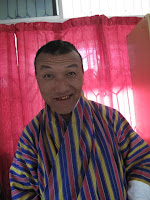 The DVDs and CDs are marked Nu 50 but can come down to Nu 20, if one can bargain.
The DVDs and CDs are marked Nu 50 but can come down to Nu 20, if one can bargain.“The quality is good. It saves time and the expense of going to a movie theatre where you’ve to pay Nu 150,” says a monk, who picks up a copy of the film, Sawadeekhrap.
The vendors selling the stuff say they buy it from Siliguri, India, while some say it comes from Nepal. They refuse to be photographed and get agitated when further questioned.Vendors claim to sell about 50 to 60 copies a day with some Bhutanese purchasing in bulk. Even music CDs of latest films like Seldrup is easily available.
“It’s disheartening to know that our movies are sold cheap across the border. If this continues, in the long run, people may stop coming to movie theatres,” said Tshering Wangyel, a prolific local filmmaker, who churns out as many as four movies a year, Bollywood style.
Tshering Wangyel said that the Bhutanese film industry is still at its infancy; therefore it’s important to curb the practice. “I don’t blame the Indians. Ultimately it’s us, the Bhutanese. It’s our negligence,” he said.
He pointed out that Bhutanese movies are copied from master copies, which is why the quality of pirated movies is good. This issue continues to confound and frustrate local film directors and producers.
“We don’t know how it’s being leaked and it’s quite disturbing,” said Wangchuk, the vice president of the motion pictures association of Bhutan (MPAB). He said that some progress had been made in the association’s investigations into the matter. “We know there are two Bhutanese guys, who are connected to the Jaigaon sellers, and who also copy the master copies in Siliguri,” he said. “But we aren’t yet able to identify them.”
In Bhutan, when movies are screened in dzongkhags, producers hire staff to screen them, explained Tshering Wangyel. “I think that’s how the copies get leaked,” he said.
Namgay Tshering of NT sound and vision said that, unless the government and the concerned agencies intervene, there would be no end. “It’s dampening the spirit of the whole film industry and its fraternity,” he said. Namgay Tshering recently filed a case with the Thimphu district court, regarding the piracy of the film, Pho-Mho’s Bartshay (Lover’s Barrier) by the producer from whom NT sound and vision bought the audiovisual rights. He is also following up on the trial of the copyright issue of his film, 49 Day I, which has been going on for more than a year, he said. “Even when people involved are taken to the court, it doesn’t serve the purpose,” he said.
But in what should be exciting news for the local film and music industry, the government demonstrated a hint of seriousness when it recently brought concerned agencies, such as the police and customs for a meeting to strengthen enforcement efforts.
Intellectual property division’s (IPD) Kencho Palden told Kuensel that a rulebook is currently being drafted to make enforcement agencies clearly aware of their roles in curbing piracy. He said that concerned agencies, including the judiciary, had not been fully aware of their responsibilities.
“The police will be able to investigate, search, confiscate pirated products and take pirates to court,” said Kencho. He added that customs would shortly begin searching for pirated goods at entry points, such as Bhutan gate in Phuentsholing.
On whether this would mean businesses currently renting and selling pirated versions of Hollywood and Bollywood films would also need to comply with copyright laws, Kencho said that, since this was already prohibited by the customs act, “at a later stage customs will have to crack down on them also.”
One of the vendors in Jaigaon said, “What’s so great about Bhutanese movies, anyways? They all appear like a remake of a Bollywood film with similar songs and dances,” he said.
Over the years, a couple of Bhutanese film songs have also been adapted from popular Tibetan and Hindi songs.
For instance, the song, Phu ru ru from Zhizang is similar to the Tibetan song, Nyenduma, and the original version of the song is in English. Similarly, tunes like Apa and Nge gi sem gi dhunghe na from sZhendhen is similar to Nge sempa khesong (Tibetan) and Dekha ek khwaab mein (Hindi).
On this, the director of the movie sZhendhen, Tshering Wangyel, opines, “It’s not fully lifted or copied but adapted. At times, whenever we do something new, coincidentally it happens to be there already,” he said. “Whatever’s adapted has our own identity. It’s performed by Bhutanese and in our national dress,” he reasons, adding that many rigsar (new songs) tunes also sound similar.
IPD’s Kencho Palden, who is a design examiner, said he did not “fully agree” with this explanation. He pointed out that, when you adapt, you still required the original author’s “specific permission”. Kencho was not sure if Bhutanese filmmakers consulted and made agreements with the authors of works they adapted.
He said cases of copyright infringement by Bhutanese filmmakers themselves are taking place. “A lot of the ideas are not original,” he said, “sometimes the entire story line is lifted from elsewhere, which is ridiculous.” He added that, if copied especially for commercial purposes, it is a direct infringement of copyright laws.
Kencho pointed out that the possibility of being sued by a Bollywood company for copyright infringement does exist. On why this has not happened yet, he explained that, since the local market was still small, legal fees would probably be more than the returns from legal action taken by an international company.





























